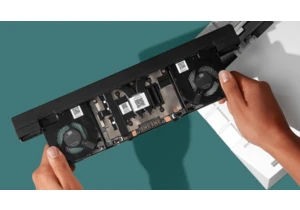Are you ready for your PC to communicate by light?
Don’t hold your breath, unfortunately. But the possibility became more real as the PCI Express Special Interest Group (PCI-SIG) said today that it’s working on a way for future PCI Express communication to take place over optical interconnections.
It was a busy day for the PCI-SIG: the standards company announced the final version of PCI Express 7.0 and that it was working on PCI Express 8 (PCIe 8) as well. Meanwhile, PCI Express 6.0 products have a good chance to ship this year, as our other story discusses.
Otherwise, you’ll have a while to wait for products based upon PCI Express 7.0. Though the final PCIe 7.0 specification was announced today, the SIG doesn’t expect compliance testing to begin until 2027. The projected date for the PCIe 7.0 integrators’ list is projected for 2028, the SIG said, when the first products will likely roll out.

PCI-SIG
Technically, PCIe 7 transfers information bidirectionally at 128 gigatransfers per second, without any encoding overhead, using the same PAM4 signaling as PCIe 6. The total bandwidth is 256GB/s across an x16 link.
The SIG hasn’t said anything about PCIe 8, but with bandwidth essentially doubling since the 8 gigatransfers/s of PCI 3.0, we can guess that the target will be 256GT/s, or the first terabyte connection (1.024TB/s) in PCI Express history.
Using light instead of electricity
Essentially, the SIG’s work takes years to migrate to the real world. In the case of silicon photonics, where electricity interfaces with light and vice versa, it can take even longer.
The other specification that the SIG announced today, or what it calls the Optical Aware Retimer Engineering Change Notice, may end up as a groundbreaking path for PCIe in and of itself. It amends the PCIe 6.4 as well as the PCIe 7.0 specification to include a PCIe retimer solution, “providing the first industry-standardized way to implement PCIe technology over optical fiber” for switch, root-complex, and endpoint silicon, the SIG said. It’s designed for “AI, cloud, and data center applications.”
Retimers can be used to synchronize clocks as the signal moves further and further from the source. That’s a more critical capability in larger data centers, at least for now.
Right now, electrical connections still rule the computing world. But Intel has been working on what’s called silicon photonics for at least a decade, and AMD acquired Enosemi in May 2025 to “develop a variety of photonics and co-packaged optics solutions across next-gen AI systems.” Those investments signal that a future based on optical connections may arrive, even if it’s some time off for now.
https://www.pcworld.com/article/2805748/pci-express-readies-for-a-jump-to-lightspeed.html
Zaloguj się, aby dodać komentarz
Inne posty w tej grupie

Your monitor may have come with a cable—but if you want the absolute

TL;DR: Grab lifetime access to a multi-model AI work

I tend to buy a lot of USB cables because they “somehow” go missing…

One of the best ways to free up space on a cluttered desk is to take

Last year, Framework expanded its options for fully modular and repai

OLED monitors aren’t exactly cheap, but Dell subsidiary Alienware def

It was previously reported by Neowin that uBlock Origin was no longer
